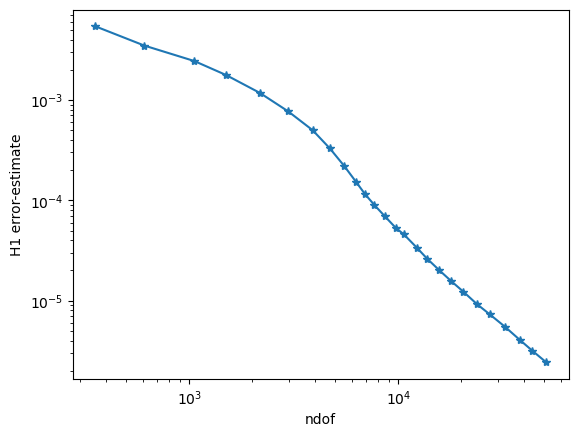This page was generated from unit-1.6-adaptivity/adaptivity.ipynb.
1.6 Error estimation & adaptive refinement¶
In this tutorial, we apply a Zienkiewicz-Zhu type error estimator and run an adaptive loop with these steps:
[1]:
from ngsolve import *
from ngsolve.webgui import Draw
from netgen.occ import *
import matplotlib.pyplot as plt
Geometry¶
The following geometry represents a heated chip embedded in another material that conducts away the heat.
[2]:
def MakeGeometryOCC():
base = Rectangle(1, 0.6).Face()
chip = MoveTo(0.5,0.15).Line(0.15,0.15).Line(-0.15,0.15).Line(-0.15,-0.15).Close().Face()
top = MoveTo(0.2,0.6).Rectangle(0.6,0.2).Face()
base -= chip
base.faces.name="base"
chip.faces.name="chip"
chip.faces.col=(1,0,0)
top.faces.name="top"
geo = Glue([base,chip,top])
geo.edges.name="default"
geo.edges.Min(Y).name="bot"
return OCCGeometry(geo, dim=2)
mesh = Mesh(MakeGeometryOCC().GenerateMesh(maxh=0.2))
Draw(mesh)
[2]:
BaseWebGuiScene
Spaces & forms¶
The problem is to find \(u\) in \(H_{0,D}^1\) satisfying
for all \(v\) in \(H_{0,D}^1\). We expect the solution to have singularities due to the nonconvex re-enrant angles and discontinuities in \(\lambda\).
[3]:
fes = H1(mesh, order=3, dirichlet=[1])
u, v = fes.TnT()
# one heat conductivity coefficient per sub-domain
lam = CoefficientFunction([1, 1000, 10])
a = BilinearForm(lam*grad(u)*grad(v)*dx)
# heat-source in inner subdomain
f = LinearForm(fes)
f = LinearForm(1*v*dx(definedon="chip"))
c = Preconditioner(a, type="multigrid", inverse="sparsecholesky")
gfu = GridFunction(fes)
Note that the linear system is not yet assembled above.
Solve¶
Since we must solve multiple times, we define a function to solve the boundary value problem, where assembly, update, and solve occurs.
[4]:
def SolveBVP():
fes.Update()
gfu.Update()
a.Assemble()
f.Assemble()
inv = CGSolver(a.mat, c.mat)
gfu.vec.data = inv * f.vec
[5]:
SolveBVP()
Draw(gfu);
Estimate¶
We implement a gradient-recovery-type error estimator. For this, we need an H(div) space for flux recovery. We must compute the flux of the computed solution and interpolate it into this H(div) space.
[6]:
space_flux = HDiv(mesh, order=2)
gf_flux = GridFunction(space_flux, "flux")
flux = lam * grad(gfu)
gf_flux.Set(flux)
Element-wise error estimator: On each element \(T\), set
where \(u_h\) is the computed solution gfu and \(I_h\) is the interpolation performed by Set in NGSolve.
[7]:
err = 1/lam*(flux-gf_flux)*(flux-gf_flux)
Draw(err, mesh, 'error_representation')
[7]:
BaseWebGuiScene
[8]:
eta2 = Integrate(err, mesh, VOL, element_wise=True)
print(eta2)
6.68417e-10
7.62254e-08
8.65452e-06
5.00116e-10
8.8811e-08
5.49489e-09
3.02529e-07
7.32725e-10
1.12641e-08
2.98627e-08
1.04189e-07
2.50948e-07
7.0518e-08
8.00722e-07
7.60703e-06
9.7881e-07
7.00995e-08
7.58091e-06
2.03482e-06
2.44616e-08
1.60629e-07
6.52305e-08
1.65889e-06
1.15213e-06
3.48558e-07
2.50622e-06
1.38426e-09
1.80477e-06
1.12638e-06
4.9493e-08
1.55159e-07
1.58315e-09
1.90147e-08
1.92754e-08
1.1525e-09
9.74872e-10
6.82708e-09
8.52244e-10
1.43383e-10
9.7114e-09
The above values, one per element, lead us to identify elements which might have large error.
Mark¶
We mark elements with large error estimator for refinement.
[9]:
maxerr = max(eta2)
print ("maxerr = ", maxerr)
for el in mesh.Elements():
mesh.SetRefinementFlag(el, eta2[el.nr] > 0.25*maxerr)
# see below for vectorized alternative
maxerr = 8.654516606473739e-06
Refine & solve again¶
Refine marked elements:
[10]:
mesh.Refine()
SolveBVP()
Draw(gfu)
[10]:
BaseWebGuiScene
Automate the above steps¶
[11]:
l = [] # l = list of estimated total error
def CalcError():
# compute the flux:
space_flux.Update()
gf_flux.Update()
flux = lam * grad(gfu)
gf_flux.Set(flux)
# compute estimator:
err = 1/lam*(flux-gf_flux)*(flux-gf_flux)
eta2 = Integrate(err, mesh, VOL, element_wise=True)
maxerr = max(eta2)
l.append ((fes.ndof, sqrt(sum(eta2))))
print("ndof =", fes.ndof, " maxerr =", maxerr)
# mark for refinement (vectorized alternative)
mesh.ngmesh.Elements2D().NumPy()["refine"] = eta2.NumPy() > 0.25*maxerr
[12]:
CalcError()
mesh.Refine()
ndof = 355 maxerr = 5.091895627858535e-06
Run the adaptive loop¶
[13]:
level = 0
while fes.ndof < 50000:
SolveBVP()
level = level + 1
if level%5 == 0:
print('adaptive step #', level)
Draw(gfu)
CalcError()
mesh.Refine()
ndof = 610 maxerr = 2.0453848565314696e-06
ndof = 1057 maxerr = 8.120392556993263e-07
ndof = 1498 maxerr = 3.221537925926478e-07
ndof = 2176 maxerr = 1.2779488709499787e-07
adaptive step # 5
ndof = 2977 maxerr = 5.06781462345477e-08
ndof = 3895 maxerr = 2.0093310174648995e-08
ndof = 4711 maxerr = 8.09145096174391e-09
ndof = 5509 maxerr = 3.867954263629141e-09
ndof = 6271 maxerr = 1.8531027594452985e-09
adaptive step # 10
ndof = 6934 maxerr = 8.88873035128996e-10
ndof = 7678 maxerr = 4.266427654424434e-10
ndof = 8611 maxerr = 2.0484739430865906e-10
ndof = 9745 maxerr = 9.837170261932046e-11
ndof = 10642 maxerr = 4.724468645516283e-11
adaptive step # 15
ndof = 12292 maxerr = 2.269123834653759e-11
ndof = 13735 maxerr = 1.0898484736126913e-11
ndof = 15721 maxerr = 5.234627253829308e-12
ndof = 17944 maxerr = 2.514237295738489e-12
ndof = 20470 maxerr = 1.2076188731971778e-12
adaptive step # 20
ndof = 23848 maxerr = 5.800220062924014e-13
ndof = 27451 maxerr = 2.78597341497768e-13
ndof = 32353 maxerr = 1.3380949493492418e-13
ndof = 38077 maxerr = 6.427239228959311e-14
ndof = 43858 maxerr = 3.0869439730437846e-14
adaptive step # 25
ndof = 51115 maxerr = 1.48274888169689e-14
Plot history of adaptive convergence¶
[14]:
plt.yscale('log')
plt.xscale('log')
plt.xlabel("ndof")
plt.ylabel("H1 error-estimate")
ndof,err = zip(*l)
plt.plot(ndof,err, "-*")
plt.ion()
plt.show()
